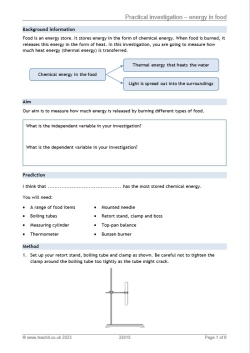Practical investigation – energy in food

A simple food calorimetry practical in which key stage 3 students investigate the energy content of food samples.
Students begin by identifying the independent variable and dependent variable. They form a hypothesis about which type of food contains the largest amount of energy and then burn different foods to test their hypothesis.
This investigation uses the difference in temperature as a measure of how much energy is in the different types of food. For each sample, they record the mass before heating, the mass after heating, the starting temperature, the finishing temperature and the temperature difference. They draw a graph of the difference in temperature before forming a conclusion. Finally, they think critically about whether the investigation was a fair test and how it could be improved.
Students could test a range of high-energy items from different food groups – carbohydrates, such as potato; foods containing lipids, such as cheese or crisps; and foods containing glucose, such as sweets or marshmallows. A link to information about food allergies is provided.
You will also need:
- Boiling tubes
- Measuring cylinder
- Thermometer
- Mounted needle
- Retort stand, clamp and boss
- Top-pan balance
- Bunsen burner.
The background information from this resource:
Food is an energy store. It stores energy in the form of chemical energy. When food is burned, it releases this energy in the form of heat. In this investigation, you are going to measure how much heat energy (thermal energy) is transferred.
